- Accueil
- Pages cachées
- 18 JUIN 2023 NEWS
18 JUIN 2023 NEWS
INSTITUT SUPERIEUR D'ANTHROPOLOGIE
INSTITUTE OF ANTHROPOLOGY
ONLINE COURSES / COURS A DISTANCE
DEBUT COURS : SEPTEMBRE 2023
REGISTER NOW
ANGLETERRE –  Harnham - Archaeologists have discovered a vast cemetery of Bronze Age burial mounds, thought to be up to 4,400 years old, ahead of a building development less than 10 miles (16 kilometers) from Stonehenge. The cemetery includes more than 20 circular mounds, known as barrows, built between 2400 B.C. and 1500 B.C. on a chalk hillside near Harnham on the outskirts of Salisbury in southwest England. Other than the site's proximity to Stonehenge, there's no evidence that the cemetery was connected with the famous monument. But the barrows were built around the same time as some of the central stages of Stonehenge, The newfound barrows range in size, with the smallest measuring about 33 feet (10 meters) across and the largest spanning 165 feet (50 m). But most of the barrows are between 65 and 100 feet (20 and 30 m) across. The barrows at the cemetery are grouped in "pairs or small clusters of six or so” One of the barrows was originally enclosed by an oval-shaped ditch that was replaced in prehistory with a nearly circular ditch. That suggests this barrow might have been built before the others, during the Neolithic period, which ended around 2400 B.C.; a mass grave near its center held the skeletal remains of adults and children, the statement said. The oval ditch also cut through pits of red deer (Cervus elaphus) antlers, which were highly prized in the Neolithic for making tools, ritual artifacts, and small items like pins and combs. The antlers will now be checked for signs of deliberate breakage or wear that could indicate they were once used to make tools, the statement said. The archaeologists have excavated the remains of nine other burials and three artifacts from graves among the barrows. In some cases, the grave goods were pottery "beakers" — distinctive round drinking vessels — indicating that the people buried there were from the Bronze Age "Bell Beaker culture," which was widespread in Britain after about 2450 B.C. The Cotswold Archaeology team has also found evidence of later occupations at the site, including what may be traces of an Iron Age cultivation area. It consists of more than 240 pits and postholes. Some of the pits may have been used to store grain, but most were used for discarding rubbish — a boon to archaeologists studying how people lived and farmed the land at that time. The team also found evidence of a Saxon building at the site, along with other artifacts from the Anglo-Saxon age (fifth to 11th centuries A.D.)
Harnham - Archaeologists have discovered a vast cemetery of Bronze Age burial mounds, thought to be up to 4,400 years old, ahead of a building development less than 10 miles (16 kilometers) from Stonehenge. The cemetery includes more than 20 circular mounds, known as barrows, built between 2400 B.C. and 1500 B.C. on a chalk hillside near Harnham on the outskirts of Salisbury in southwest England. Other than the site's proximity to Stonehenge, there's no evidence that the cemetery was connected with the famous monument. But the barrows were built around the same time as some of the central stages of Stonehenge, The newfound barrows range in size, with the smallest measuring about 33 feet (10 meters) across and the largest spanning 165 feet (50 m). But most of the barrows are between 65 and 100 feet (20 and 30 m) across. The barrows at the cemetery are grouped in "pairs or small clusters of six or so” One of the barrows was originally enclosed by an oval-shaped ditch that was replaced in prehistory with a nearly circular ditch. That suggests this barrow might have been built before the others, during the Neolithic period, which ended around 2400 B.C.; a mass grave near its center held the skeletal remains of adults and children, the statement said. The oval ditch also cut through pits of red deer (Cervus elaphus) antlers, which were highly prized in the Neolithic for making tools, ritual artifacts, and small items like pins and combs. The antlers will now be checked for signs of deliberate breakage or wear that could indicate they were once used to make tools, the statement said. The archaeologists have excavated the remains of nine other burials and three artifacts from graves among the barrows. In some cases, the grave goods were pottery "beakers" — distinctive round drinking vessels — indicating that the people buried there were from the Bronze Age "Bell Beaker culture," which was widespread in Britain after about 2450 B.C. The Cotswold Archaeology team has also found evidence of later occupations at the site, including what may be traces of an Iron Age cultivation area. It consists of more than 240 pits and postholes. Some of the pits may have been used to store grain, but most were used for discarding rubbish — a boon to archaeologists studying how people lived and farmed the land at that time. The team also found evidence of a Saxon building at the site, along with other artifacts from the Anglo-Saxon age (fifth to 11th centuries A.D.)
GRECE –  Parnitha - On Thursday morning, a significant number of archaeological artifacts were discovered in a forested area of the Parnitha National Park, a densely forested mountain range north of Athens. Among the finds were lamps, pottery, and bronze figurines. Greek media reported on the list of finds but few details have been given on precisely what period they date to. Historically, Parnitha marked the boundary between the mainland territories of ancient Athens and Boeotia. A list of the archaeological items located in Parnitha was reported by the Greek media, although scant details have been made available relating to their date or origin. From the photo that has been posted online, some of the pottery finds appear to have been painted in the black and red-figure pottery styles popular in ancient Greece from the late 6th to the late 4th century BC.
Parnitha - On Thursday morning, a significant number of archaeological artifacts were discovered in a forested area of the Parnitha National Park, a densely forested mountain range north of Athens. Among the finds were lamps, pottery, and bronze figurines. Greek media reported on the list of finds but few details have been given on precisely what period they date to. Historically, Parnitha marked the boundary between the mainland territories of ancient Athens and Boeotia. A list of the archaeological items located in Parnitha was reported by the Greek media, although scant details have been made available relating to their date or origin. From the photo that has been posted online, some of the pottery finds appear to have been painted in the black and red-figure pottery styles popular in ancient Greece from the late 6th to the late 4th century BC.
https://greekreporter.com/2023/06/15/archaeological-treasures-mount-parnitha/
HAWAII – 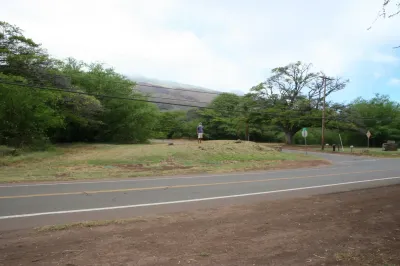
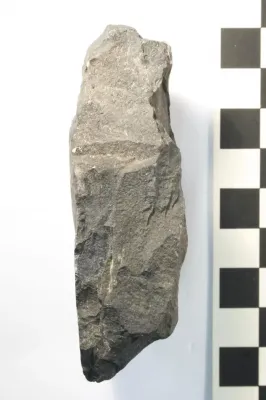 Kawela - Along Molokaʻi's south central coastline in Kawela, a raised mound along Kamehameha V Highway holds 900 years of stories.“There are a group of sites that we call early sites (across Hawaiʻi) and these date to about the 1300s, 1400s. But the bottom of the Kawela Mound dates to about the 1100s, up until the early 1200s. So that's one of the most comprehensively dated habitation areas in the whole Hawaiian Islands," said archeologist Marshall Weisler. Weisler is a professor at the University of Queensland in New Zealand and has been working in archeology in the Pacific Islands for nearly 50 years. Over that time, he has studied dozens of sites on Molokaʻi. He originally excavated the Kawela Mound in 1981 and concluded that its contents were about 500 years old. But since then, radiocarbon dating technology and methods have greatly improved, and he recently re-dated samples. He was surprised to find out the site was, in fact, about 900 years old. Weisler says each layer of the mound tells a different story."Inside those layers is the evidence of people living on the landscape, and that's an incredible time capsule because it not only tells us about people, but it tells us about the environment.” The area is now dry and hot, but for hundreds of years, the Kawela Stream brought ample fresh water to the coastal region. Nearby, the Kakahaiʻa Pond used to be fed by springs, creating a marshy wetland perfect for growing kalo. Weisler found evidence of species living centuries ago that are no longer found in Kawela.The discovery also changes what archeologists previously presumed about the location of Hawaiʻi’s earliest settlements. Lush, windward areas were believed to have been more attractive to early agricultural Polynesians, but Kawela’s leeward location proves that theory wrong. He describes the site as a "habitation mound." “It's where people lived and there are tens of thousands of bones of fish. There's hundreds of bones of pig, dog, chicken, nēnē, other birds, urchins. It's loaded with food and there's imu, there's earth ovens... There's post molds where houses used to be. There's evidence that people were making stone tools like adzes...”Weisler said one of the most interesting discoveries of early habitations across the eastern Pacific, from New Zealand to Rapa Nui and Hawaiʻi, is that they all date to within about a century of each other.“It's the most incredible over-water migration in the whole history of humans. And it took place in the eastern part of the Pacific, and part of that story is Hawaiʻi. And part of that story, now, is this Kawela mound site," he said.
Kawela - Along Molokaʻi's south central coastline in Kawela, a raised mound along Kamehameha V Highway holds 900 years of stories.“There are a group of sites that we call early sites (across Hawaiʻi) and these date to about the 1300s, 1400s. But the bottom of the Kawela Mound dates to about the 1100s, up until the early 1200s. So that's one of the most comprehensively dated habitation areas in the whole Hawaiian Islands," said archeologist Marshall Weisler. Weisler is a professor at the University of Queensland in New Zealand and has been working in archeology in the Pacific Islands for nearly 50 years. Over that time, he has studied dozens of sites on Molokaʻi. He originally excavated the Kawela Mound in 1981 and concluded that its contents were about 500 years old. But since then, radiocarbon dating technology and methods have greatly improved, and he recently re-dated samples. He was surprised to find out the site was, in fact, about 900 years old. Weisler says each layer of the mound tells a different story."Inside those layers is the evidence of people living on the landscape, and that's an incredible time capsule because it not only tells us about people, but it tells us about the environment.” The area is now dry and hot, but for hundreds of years, the Kawela Stream brought ample fresh water to the coastal region. Nearby, the Kakahaiʻa Pond used to be fed by springs, creating a marshy wetland perfect for growing kalo. Weisler found evidence of species living centuries ago that are no longer found in Kawela.The discovery also changes what archeologists previously presumed about the location of Hawaiʻi’s earliest settlements. Lush, windward areas were believed to have been more attractive to early agricultural Polynesians, but Kawela’s leeward location proves that theory wrong. He describes the site as a "habitation mound." “It's where people lived and there are tens of thousands of bones of fish. There's hundreds of bones of pig, dog, chicken, nēnē, other birds, urchins. It's loaded with food and there's imu, there's earth ovens... There's post molds where houses used to be. There's evidence that people were making stone tools like adzes...”Weisler said one of the most interesting discoveries of early habitations across the eastern Pacific, from New Zealand to Rapa Nui and Hawaiʻi, is that they all date to within about a century of each other.“It's the most incredible over-water migration in the whole history of humans. And it took place in the eastern part of the Pacific, and part of that story is Hawaiʻi. And part of that story, now, is this Kawela mound site," he said.
ALLEMAGNE – 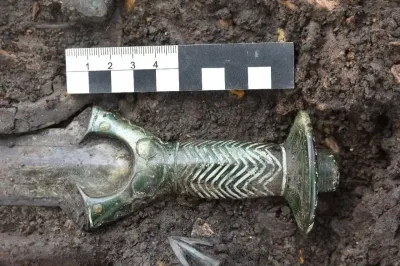
 Nördlingen - Archaeologists discovered a bronze sword more than 3,000 years old during excavations in the town of Nördlingen in Bavaria, Germany. The sword was found among a deposit of grave goods and weaponry, alongside the remains of a man, woman, and child. It is still unclear what relationship the people may have had with one another It is an octagonal sword with an octagonal hilt made entirely of bronze. The production of octagonal swords is complex because the handle is cast over the blade (so-called overlay casting). The decoration is made with an inlay and using hallmarks. While there are two real rivets, another pair of rivets is only implied. Despite the manufacturing effort and the lack of signs of a blow, it can be assumed that it was a real weapon. The center of gravity in the front part of the blade indicates a predominantly slashing balance. Whether the sword was Bavaria crafted or was imported is currently being investigated. There are three main distribution centers during the bronze age for octagonal swords of this type, one in Southern Germany and the others in Northern Germany and Denmark. Comparing the casting methods and the decoration reveals that while some of the octagonal swords in the North may be genuine imports or the work of “wandering craftsmen,” others may be copies of South German designs.
Nördlingen - Archaeologists discovered a bronze sword more than 3,000 years old during excavations in the town of Nördlingen in Bavaria, Germany. The sword was found among a deposit of grave goods and weaponry, alongside the remains of a man, woman, and child. It is still unclear what relationship the people may have had with one another It is an octagonal sword with an octagonal hilt made entirely of bronze. The production of octagonal swords is complex because the handle is cast over the blade (so-called overlay casting). The decoration is made with an inlay and using hallmarks. While there are two real rivets, another pair of rivets is only implied. Despite the manufacturing effort and the lack of signs of a blow, it can be assumed that it was a real weapon. The center of gravity in the front part of the blade indicates a predominantly slashing balance. Whether the sword was Bavaria crafted or was imported is currently being investigated. There are three main distribution centers during the bronze age for octagonal swords of this type, one in Southern Germany and the others in Northern Germany and Denmark. Comparing the casting methods and the decoration reveals that while some of the octagonal swords in the North may be genuine imports or the work of “wandering craftsmen,” others may be copies of South German designs.
https://arkeonews.net/archaeologists-find-a-3000-year-old-bronze-sword-in-germany/
GALLES – 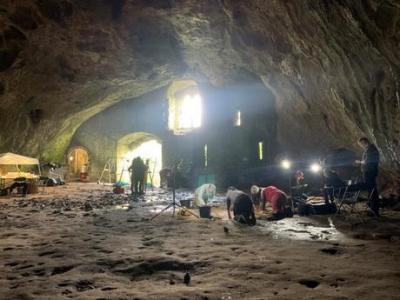 Wogan Cavern - Archaeologists have discovered extremely rare evidence for early Homo sapiens in Britain. The finds of stone tools and animal bones, dating to the last Ice Age, were found during archaeological excavations at Pembroke Castle’s Wogan Cavern. Their excavations will continue this summer. Wogan Cavern is a large cave underneath Pembroke Castle. In the early 13th century, a wall was built across the cave mouth. It is now accessed via a spiral stairway from the castle above. A team of archaeologists have so far excavated only a very small part of the cave but their finds already make it among the most important archaeological caves in Britain. The team found evidence for multiple early prehistoric hunter-gatherer occupations over tens of thousands of years, stretching back into the last Ice Age. Post-excavation analysis of stone tools found during the 2022 dig confirms that the tools were left behind by some of the earliest Homo sapiens to come to Britain, during the middle of the last Ice Age. They were found alongside the bones of Ice Age animals, including reindeer, wild horse and woolly mammoth.
Wogan Cavern - Archaeologists have discovered extremely rare evidence for early Homo sapiens in Britain. The finds of stone tools and animal bones, dating to the last Ice Age, were found during archaeological excavations at Pembroke Castle’s Wogan Cavern. Their excavations will continue this summer. Wogan Cavern is a large cave underneath Pembroke Castle. In the early 13th century, a wall was built across the cave mouth. It is now accessed via a spiral stairway from the castle above. A team of archaeologists have so far excavated only a very small part of the cave but their finds already make it among the most important archaeological caves in Britain. The team found evidence for multiple early prehistoric hunter-gatherer occupations over tens of thousands of years, stretching back into the last Ice Age. Post-excavation analysis of stone tools found during the 2022 dig confirms that the tools were left behind by some of the earliest Homo sapiens to come to Britain, during the middle of the last Ice Age. They were found alongside the bones of Ice Age animals, including reindeer, wild horse and woolly mammoth.
https://www.abdn.ac.uk/news/22035/
MONGOLIE – 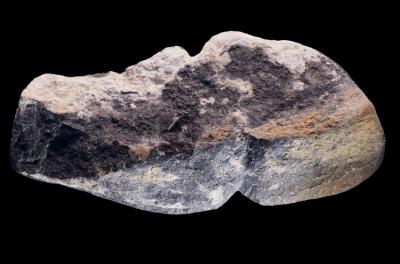 Tolbor - A pendant recently found in northern Mongolia suggests our species has been artistically recreating the penis for at least 42,000 years. According to researchers behind a study of the pendant, published this week in Nature Scientific Reports, the 4.3-centimeter piece of carved graphite is the “earliest-known sexed anthropomorphic representation.” If so, the pendant would predate cave art at Grotte Chauvet in France that depicts vulvas and dates back 32,000 years. It would even edge out the Venus of Hohle Fels statue found in southwestern Germany that may be as old as 40,000 years. But not everyone is convinced that the Mongolian pendant represents a phallus. The pendant was unearthed in 2016 at site called Tolbor in Mongolia’s northern Khangai Mountains. Radiocarbon dating of organic material found near it puts the artifact at between 42,400 and 41,900 years old. A fragment of an ostrich eggshell pendant, ostrich eggshell beads, other stone pendants, and animal bone pieces were also found in the same sedimentary layer. Solange Rigaud, an archaeologist at the University of Bordeaux and the study’s lead author, thinks the strongest argument for the pendant as a phallic representation comes from the features its maker focused on. “Our argument is that when you want to represent something abstractly, you will choose very specific features that really characterize what you want to represent,” she says. For example, the carver appears to have taken care to define the urethral opening, she notes, and to distinguish the glans from the shaft. A combination of microscopy and other surface analyses show that stone tools were likely used to carve out the grooves for both the urethra and the glans. The pendant was also discovered to be smoother on the back than the front; a string was likely fastened around the glans, suggesting the ornament may have been worn around the neck. The amount of wear on the surface suggests it was likely handed down across multiple generations. Graphite wasn’t widely available near Tolbor, suggesting the pendant may have come from elsewhere, perhaps through trade. But phallic imagery is often in the eye of the beholder, “like a face in a cloud,” says Curtis Runnels, an archaeologist at Boston University who was not involved in the study. He called the pendant a “small and rather shapeless object” and said he “would need to be convinced” that it was intended to represent a penis.If the pendant does reflect a phallus, it reinforces the notion that some of the earliest forms of symbolic thinking are found on personal ornaments, the authors say. The oldest jewelry includes shell beads found in Africa, dating back at least 60,000 years and perhaps up to 142,000 years. The pendant is “important because it highlights very specific cognitive capacities in our lineage”—that is, the ability to attach meaning to symbolic representations—which is one of the hallmarks of being human, Rigaud says.
Tolbor - A pendant recently found in northern Mongolia suggests our species has been artistically recreating the penis for at least 42,000 years. According to researchers behind a study of the pendant, published this week in Nature Scientific Reports, the 4.3-centimeter piece of carved graphite is the “earliest-known sexed anthropomorphic representation.” If so, the pendant would predate cave art at Grotte Chauvet in France that depicts vulvas and dates back 32,000 years. It would even edge out the Venus of Hohle Fels statue found in southwestern Germany that may be as old as 40,000 years. But not everyone is convinced that the Mongolian pendant represents a phallus. The pendant was unearthed in 2016 at site called Tolbor in Mongolia’s northern Khangai Mountains. Radiocarbon dating of organic material found near it puts the artifact at between 42,400 and 41,900 years old. A fragment of an ostrich eggshell pendant, ostrich eggshell beads, other stone pendants, and animal bone pieces were also found in the same sedimentary layer. Solange Rigaud, an archaeologist at the University of Bordeaux and the study’s lead author, thinks the strongest argument for the pendant as a phallic representation comes from the features its maker focused on. “Our argument is that when you want to represent something abstractly, you will choose very specific features that really characterize what you want to represent,” she says. For example, the carver appears to have taken care to define the urethral opening, she notes, and to distinguish the glans from the shaft. A combination of microscopy and other surface analyses show that stone tools were likely used to carve out the grooves for both the urethra and the glans. The pendant was also discovered to be smoother on the back than the front; a string was likely fastened around the glans, suggesting the ornament may have been worn around the neck. The amount of wear on the surface suggests it was likely handed down across multiple generations. Graphite wasn’t widely available near Tolbor, suggesting the pendant may have come from elsewhere, perhaps through trade. But phallic imagery is often in the eye of the beholder, “like a face in a cloud,” says Curtis Runnels, an archaeologist at Boston University who was not involved in the study. He called the pendant a “small and rather shapeless object” and said he “would need to be convinced” that it was intended to represent a penis.If the pendant does reflect a phallus, it reinforces the notion that some of the earliest forms of symbolic thinking are found on personal ornaments, the authors say. The oldest jewelry includes shell beads found in Africa, dating back at least 60,000 years and perhaps up to 142,000 years. The pendant is “important because it highlights very specific cognitive capacities in our lineage”—that is, the ability to attach meaning to symbolic representations—which is one of the hallmarks of being human, Rigaud says.
POLOGNE – 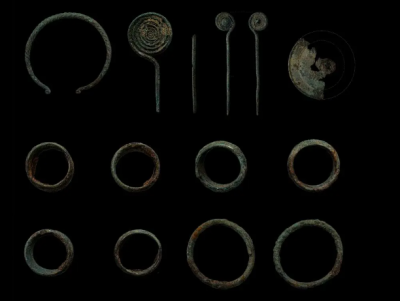 Czerniecin Poduchowny - A total of 13 bronze artefacts dating from 2,500-years-ago have been located, including pins for clothing, shin guards, and bracelets which are associated with the Lusatian Culture. The Lusatian Culture emerged during the Late Bronze Age and expanded their territories across most of present-day Poland, parts of the Czech Republic, Slovakia, eastern Germany and western Ukraine during the Early Iron Age. Excavations of the discovery site have found two pins, a torc, fragments of a small decorative phaler, four large bracelets decorated with incised herringbone and transverse lines, four smaller bracelets, and a decorative tubular pin. Archaeologist, Wiesław Koman, said: “The find is all the more sensational, because ornaments of the Lusatian culture are very rare in the region and they are normally only single objects or fragments, and here we have a whole set of them.”
Czerniecin Poduchowny - A total of 13 bronze artefacts dating from 2,500-years-ago have been located, including pins for clothing, shin guards, and bracelets which are associated with the Lusatian Culture. The Lusatian Culture emerged during the Late Bronze Age and expanded their territories across most of present-day Poland, parts of the Czech Republic, Slovakia, eastern Germany and western Ukraine during the Early Iron Age. Excavations of the discovery site have found two pins, a torc, fragments of a small decorative phaler, four large bracelets decorated with incised herringbone and transverse lines, four smaller bracelets, and a decorative tubular pin. Archaeologist, Wiesław Koman, said: “The find is all the more sensational, because ornaments of the Lusatian culture are very rare in the region and they are normally only single objects or fragments, and here we have a whole set of them.”
https://www.heritagedaily.com/2023/06/2500-year-old-bronze-artefacts-found-in-eastern-poland/147671
EGYPTE – 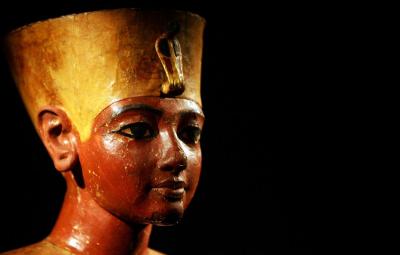 - There’s a new theory floating around and attempting to explain the 1323 death of the 19-year-old King Tutankhamun: drunk chariot racing. The idea is that—despite being an Egyptian pharaoh—King Tut was still a teenage boy, and may have combined a need for speed with ancient drunk driving to create spectacular crash that crushed one side of his body and killed him. While Sofia Aziz, a forensic Egyptologist, isn’t the only one to propose the chariot racing accident as a cause of death, her new theory—as explained to BBC Science Focus at the Cheltenham Science Festival—may just be the first to combine King Tut’s apparent love of wine with chariot racing. “He was a like a typical teenager, drinking and probably driving the chariot too fast,” Aziz told the BBC. The fresh theory comes from a simple look through the items found in King Tut’s famous tomb, originally discovered by Howard Carter in 1922. In the tradition of the day, King Tut would have been buried with objects most important to him, so he could enjoy them in the afterlife. And two of the items most prevalent in the tomb were wine (a robust collection) and chariots (six different ones). The commonly held thought, although not definitive, was that a sickly King Tut died from a combination of either a disease or a wound coupled with malaria. In 2013, a new theory emerged to explain many of these wounds: a chariot crash. Analysis at the time says that one side of his body was crushed through some sort of impact that shattered his pelvis and ribs, and destroyed his heart.
- There’s a new theory floating around and attempting to explain the 1323 death of the 19-year-old King Tutankhamun: drunk chariot racing. The idea is that—despite being an Egyptian pharaoh—King Tut was still a teenage boy, and may have combined a need for speed with ancient drunk driving to create spectacular crash that crushed one side of his body and killed him. While Sofia Aziz, a forensic Egyptologist, isn’t the only one to propose the chariot racing accident as a cause of death, her new theory—as explained to BBC Science Focus at the Cheltenham Science Festival—may just be the first to combine King Tut’s apparent love of wine with chariot racing. “He was a like a typical teenager, drinking and probably driving the chariot too fast,” Aziz told the BBC. The fresh theory comes from a simple look through the items found in King Tut’s famous tomb, originally discovered by Howard Carter in 1922. In the tradition of the day, King Tut would have been buried with objects most important to him, so he could enjoy them in the afterlife. And two of the items most prevalent in the tomb were wine (a robust collection) and chariots (six different ones). The commonly held thought, although not definitive, was that a sickly King Tut died from a combination of either a disease or a wound coupled with malaria. In 2013, a new theory emerged to explain many of these wounds: a chariot crash. Analysis at the time says that one side of his body was crushed through some sort of impact that shattered his pelvis and ribs, and destroyed his heart.
https://www.popularmechanics.com/science/archaeology/a44222456/how-did-king-tut-die-new-theory/
ROUMANIE – 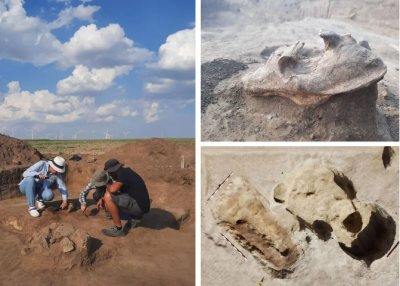 Dobruja - The mound dates from around 2,000-years-ago and has been mostly ploughed out, however, a geophysical study indicates that it originally had a diameter of up to 75 metres. A burial at the centre of the grave had a pit covered with wooden boards where the deceased was cremated inside a wooden structure. This is evidenced by small amounts of bone, a fragment of a clay lamp, and partially burnt wooden remains from the structure which was joined with nails and decorated with bronze fittings. Excavations also revealed a large number of burnt walnut seeds, pine cones and other plant remains, which is common in cremation burials from the early Roman period. Barrows with similar cremation burials were discovered in the town of Hârșova, known in the Roman period as Carsium on the lower Danube. The grave was robbed during antiquity, with the grave robbers depositing a wolf’s skull on a pile of stones which closed their robbery ditch. Dr. Bartłomiej Szymon Szmoniewski from the Institute of Archaeology and Ethnology of the Polish Academy of Sciences, said: “It was probably a ritual aimed at closing the looted space in order to prevent exit and the revenge of the plundered spirit.” According to Dr Szmoniewski, the burial was likely robbed by the Getae, a Thracian-related tribe that once inhabited the regions to either side of the Lower Danube. A second burial was also discovered in the barrow, where the researchers found a skeleton inside a wooden structure. Placed upon the skeleton is a glass unguentarium, a container for holding fragrances and perfumes, and a bronze coin from the reign of Hadrian (issued in AD 125-127) that was placed in the deceased’s mouth.
Dobruja - The mound dates from around 2,000-years-ago and has been mostly ploughed out, however, a geophysical study indicates that it originally had a diameter of up to 75 metres. A burial at the centre of the grave had a pit covered with wooden boards where the deceased was cremated inside a wooden structure. This is evidenced by small amounts of bone, a fragment of a clay lamp, and partially burnt wooden remains from the structure which was joined with nails and decorated with bronze fittings. Excavations also revealed a large number of burnt walnut seeds, pine cones and other plant remains, which is common in cremation burials from the early Roman period. Barrows with similar cremation burials were discovered in the town of Hârșova, known in the Roman period as Carsium on the lower Danube. The grave was robbed during antiquity, with the grave robbers depositing a wolf’s skull on a pile of stones which closed their robbery ditch. Dr. Bartłomiej Szymon Szmoniewski from the Institute of Archaeology and Ethnology of the Polish Academy of Sciences, said: “It was probably a ritual aimed at closing the looted space in order to prevent exit and the revenge of the plundered spirit.” According to Dr Szmoniewski, the burial was likely robbed by the Getae, a Thracian-related tribe that once inhabited the regions to either side of the Lower Danube. A second burial was also discovered in the barrow, where the researchers found a skeleton inside a wooden structure. Placed upon the skeleton is a glass unguentarium, a container for holding fragrances and perfumes, and a bronze coin from the reign of Hadrian (issued in AD 125-127) that was placed in the deceased’s mouth.
NOUVELLE ZELANDE – 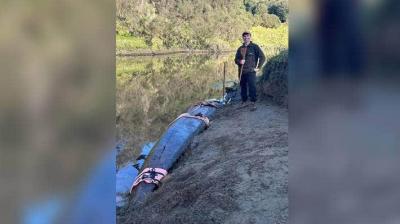 Taranaki - A waka -the traditional canoe of the Maori people- believed to be over 150 years old has been salvaged from the Pātea River in the Taranaki region of western New Zealand. The rare find is being described as a valuable link to the heritage of local iwi, Te Pakakohi, Ngāti Ruanui, and Ngā Rauru. Local people have speculated that waka was intentionally hidden by their Maori ancestors to prevent it from being confiscated by the British colonial government in the 19th century. The waka was discovered last week by contractors for Manawa Energy, which owns the Pātea hydro scheme, who were walking along the riverbanks to monitor eels in the river below the dam. The waka, which is 8 meters, long lifted out on Wednesday by helicopter, accompanied by waiata and karakia. It was stuck in the mud at the river’s edge, easily identifiable because of its long, curved shape.
Taranaki - A waka -the traditional canoe of the Maori people- believed to be over 150 years old has been salvaged from the Pātea River in the Taranaki region of western New Zealand. The rare find is being described as a valuable link to the heritage of local iwi, Te Pakakohi, Ngāti Ruanui, and Ngā Rauru. Local people have speculated that waka was intentionally hidden by their Maori ancestors to prevent it from being confiscated by the British colonial government in the 19th century. The waka was discovered last week by contractors for Manawa Energy, which owns the Pātea hydro scheme, who were walking along the riverbanks to monitor eels in the river below the dam. The waka, which is 8 meters, long lifted out on Wednesday by helicopter, accompanied by waiata and karakia. It was stuck in the mud at the river’s edge, easily identifiable because of its long, curved shape.
https://arkeonews.net/rare-waka-unearthed-from-new-zealand-river-after-being-hidden-for-153-years/
ISLANDE – 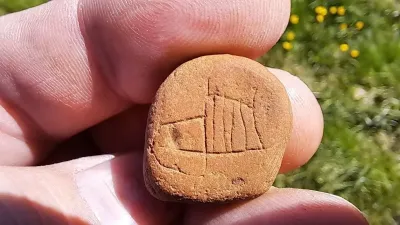
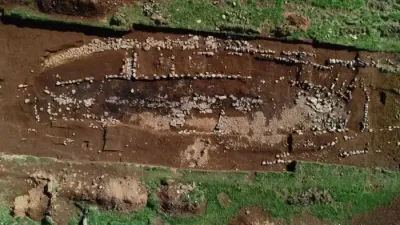 Stöð on Stöðvarfjörður - Archaeologists in East Iceland have found a sandstone carved with a Viking ship that may be the oldest picture ever found in the country. The stone was found at the archaeological site Stöð on Stöðvarfjörður in East Iceland in a longhouse that is believed to predate the permanent settlement of the island. “Bjarni F. Einarsson, the archaeologist leading the excavation, says that the stone was found in the wall of the older cabin. Such carvings of ships are quite common in the Nordic countries, carved in bone, wood, or stone. This is the first drawing of a ship that he knows of that has been found in Iceland and must be the oldest drawing in the country,” RÚV reports. The first exploratory digs at Stöð took place in 2015, and archaeologists have returned every summer since to continue excavating the site, where they initially concentrated their efforts on a settlement-era longhouse. “The longhouse is among the largest found in Iceland, 31.4m [103ft] long. In Scandinavia, only chieftains’ farms had longhouses larger than 28m [92ft]. It is also the richest longhouse ever excavated in Iceland. We have found 92 beads and 29 silver objects, including Roman and Middle Eastern coins,” Bjarni F. Einarsson told Iceland Review. The discovery of an even older longhouse beneath the settlement-era longhouse, estimated to date back to around 800 AD, some 75 years before Iceland’s permanent settlement, adds to the significance of the site. The absence of domesticated animal bones is the most noticeable feature of the older structure. “My theory is that the older longhouse was a seasonal hunting camp, operated by a Norwegian chief who outfitted voyages to Iceland to gather valuables and bring them back across the sea to Norway,” Bjarni told Iceland Review. One of these valuables may have been walrus ivory: in 2019, DNA analyses and radiocarbon dating confirmed that Iceland was previously inhabited by a North Atlantic subspecies of walrus, now extinct. Archaeologists used survey equipment this spring to scan a larger area around Stöð and discovered evidence of additional structures and boat burial sites.
Stöð on Stöðvarfjörður - Archaeologists in East Iceland have found a sandstone carved with a Viking ship that may be the oldest picture ever found in the country. The stone was found at the archaeological site Stöð on Stöðvarfjörður in East Iceland in a longhouse that is believed to predate the permanent settlement of the island. “Bjarni F. Einarsson, the archaeologist leading the excavation, says that the stone was found in the wall of the older cabin. Such carvings of ships are quite common in the Nordic countries, carved in bone, wood, or stone. This is the first drawing of a ship that he knows of that has been found in Iceland and must be the oldest drawing in the country,” RÚV reports. The first exploratory digs at Stöð took place in 2015, and archaeologists have returned every summer since to continue excavating the site, where they initially concentrated their efforts on a settlement-era longhouse. “The longhouse is among the largest found in Iceland, 31.4m [103ft] long. In Scandinavia, only chieftains’ farms had longhouses larger than 28m [92ft]. It is also the richest longhouse ever excavated in Iceland. We have found 92 beads and 29 silver objects, including Roman and Middle Eastern coins,” Bjarni F. Einarsson told Iceland Review. The discovery of an even older longhouse beneath the settlement-era longhouse, estimated to date back to around 800 AD, some 75 years before Iceland’s permanent settlement, adds to the significance of the site. The absence of domesticated animal bones is the most noticeable feature of the older structure. “My theory is that the older longhouse was a seasonal hunting camp, operated by a Norwegian chief who outfitted voyages to Iceland to gather valuables and bring them back across the sea to Norway,” Bjarni told Iceland Review. One of these valuables may have been walrus ivory: in 2019, DNA analyses and radiocarbon dating confirmed that Iceland was previously inhabited by a North Atlantic subspecies of walrus, now extinct. Archaeologists used survey equipment this spring to scan a larger area around Stöð and discovered evidence of additional structures and boat burial sites.